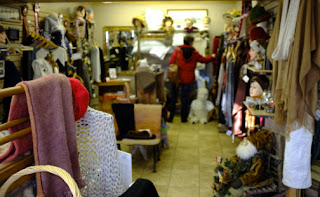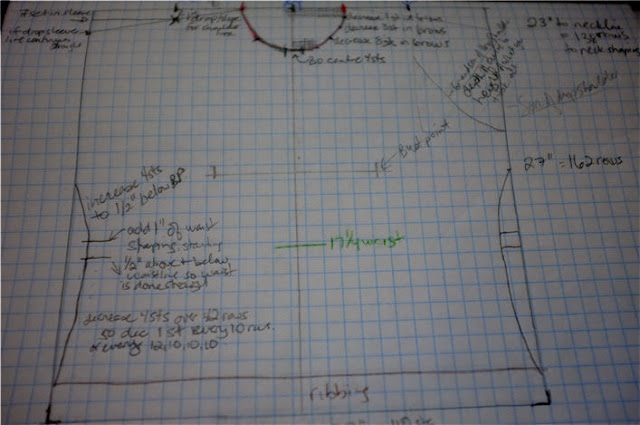I thought I'd celebrate the newest book from one of my favourite design teams, Tin Can Knits, by interviewing Emily Wessel, one half of the dynamic design duo.
But before we start the interview....
GIVEAWAY!
In addition, I'm going to give away a copy of one of their books. Leave a comment, get your friends to leave comments, by 11:59pm EST, Sunday, Nov 25th, 2012 and one lucky winner
(selected by random number generator) will receive the e-book of their choice from Tin Can Knits. Don't forget to either leave your Ravelry name or check back on Monday to see if you've won!
How did Tin Can Knits get started?
We
met while we were both working at our local yarn shop - Urban Yarns in
Vancouver. A year, two moves, and some crazy ideas later Alexa and I
decided to put together our first book: 9 Months of Knitting. Alexa was
pregnant, so baby projects were on her mind!
 |
| Photo courtesy of Alexa Ludeman |
How do you & Alexa decide who does what in your partnership?
The
division of labour at Tin Can Knits happened organically; essentially
we try to play to our strengths. Alexa and I both bring very different
things to the partnership. I am trained as an architect, and so I come
from a background of design, layout, and producing detailed
documentation for construction... not that far off of the requirements
for pattern design and technical editing, so I take the lead on that
side of things. Alexa is avid photographer, and has a great eye for
colour and a great sense of what will be desirable in a knitting
project. She is trained as a teacher, and has taught knitting for
years, so she always has great ideas for projects that would work well
for beginners and people learning new techniques.
Where do you find your inspiration?
We
find that inspiration is everywhere. We are mostly inspired to make
things for our families, our friends, and ourselves, really! I find my
best ideas strike when I am relaxing and allow my mind to wander. Alexa
finds a lot of inspiration through her photography, travel and
teaching.
Do you have a favorite knitting technique, either personally or that you like to feature in your designs?
Alexa
and I are always learning new techniques and incorporating them into
our designs. I love lace, which is pretty obvious given my lace designs! Alexa is a total sucker for cables.
There are few techniques which I don't like! I have recently learned
intarsia for example, and immediately used it in two sweater designs,
and I have a design for next year's book which will use that technique.
For me any technique is simply a means to achieve the finished result
that I desire!
 |
| Photo courtesy of Alexa Ludeman |
One of the unique things about your designs is the tremendous range of sizes, from infant to adult plus sizes. What was the thinking behind that?
As designers, we believe strongly in providing good value, and making
user-friendly designs which are accessible to a wide range of knitters.
We saw how many adorable adult patterns there were which would be
amazing if re-imagined for babies, and at the same time, how many baby
patterns would be adorable on adults, and saw an opportunity. Also,
sizing patterns to 4XL just seems like the right thing to do; there are
many plus-sized knitters; and we believe our designs should be
accessible to everybody. While the decision to size our patterns from
baby to grandpa requires some consideration in the initial design, and
more time in pattern writing / editing / testing phases, we believe that
it is worthwhile, and we hope knitters agree! On a less serious note,
we just think it is mind-blowingly adorable to have matching mommy -
baby knits!
Are there any designers in the knitting world who inspire you?
Elizabeth Zimmerman, Jane
Richmond, Brooklyn Tweed, Joelle Hoverson, Debbie Stoller, Ysolda
Teague, Barbara Walker, Alice Starmore, Kaffe Fassett, Kate Davies...
and many more!
What have you learned since you've published your first pattern?
Since
Alexa and I published our first pattern, we have learned basically
everything; and we are still learning from our fans, our pattern
testers, and through critiques from our peers in the design world.
What we are getting better and better at is taking an idea from concept
through to completion in a structured way. When we wrote 9 Months of
Knitting, we didn't have a grand vision of how the collection would be
styled, and it just came together organically. With Pacific Knits we
developed a clear idea of style and the contents the book needed to have
early on. Great White North was imagined / styled / and a pattern list
created all at once, so it has a very cohesive aesthetic.
What are your goals for Tin Can Knits? How do you define success for TCK?
Right
now we are focused on building a business that will be sustainable
long-term and allow us to have flexible schedules. As a woman coming
from a professional full-time background, who is looking forward to
having children, my dream is to be self-employed and have flexibility
that will be beneficial when I do have kids. Alexa would love to
continue to stay home with Hunter and Jones. So while we do have
grander visions for the business, we define success by our ability to
create our own professional jobs, which allow us some flexibility in
balancing work family obligations.
Tell me about your collection of patterns. I understand you have a new book of patterns out for the holidays.
Our first design 'baby' was
9 Months of Knitting (2011)... not surprisingly coinciding with Alexa's first baby!
The second (and my most beloved) is
Pacific Knits
(2012), which is packed with designs that I personally love to death
and nostalgia-inspiring photography of my homeland. I just think it is a
great example of our best work. Interestingly enough, Alexa delivered
her second baby, late, about 24 hours after Pacific Knits went to
print! I felt really guilty asking her to edit and take more
last-minute photos when she was past her due date... but I did ask!
We have just launched our third collection as an ebook :
Great White North (2012), and is has some really adorable gift knits inspired by the holiday season.
 |
| Photo courtesy of Alexa Ludeman |
Do you have a favorite pattern in the collection? If so, what is it about that pattern that attracts you to it?
I can't really talk about my favourites... but I did
almost stop editing mid-way through the collection in order to cast on a
Snowflake sweater for myself... And Alexa keeps making noises about
making a Drift blanket for Jones (to which I reply 'you don't have time
to knit a blanket!'). Also I plan to knit a bunch of Fancy Balls (free
pattern!) for Christmas gifting this year! Oh my... so much to knit and
so little time!
Thanks to Emily of TCK for taking the time to chat with me. Now it's time for me to find the perfect yarn to cast on for
Drift!
 Inspired by a dear friend who convinced me to give toe-up socks a
chance, these socks are a quick and satisfying knit. The lines flow into
one another, reminding me of swirls of water or ripples on a field of
snow on a winter morning.
Inspired by a dear friend who convinced me to give toe-up socks a
chance, these socks are a quick and satisfying knit. The lines flow into
one another, reminding me of swirls of water or ripples on a field of
snow on a winter morning.

 Inspired by some richly toned Handmaiden Casbah yarn, these socks were
created to do justice to this lovely yarn. I wanted a pattern that was
as voluptuous as the Casbah itself. For me, that means bold, stunning
cables that capture the eye immediately.
Inspired by some richly toned Handmaiden Casbah yarn, these socks were
created to do justice to this lovely yarn. I wanted a pattern that was
as voluptuous as the Casbah itself. For me, that means bold, stunning
cables that capture the eye immediately.





















